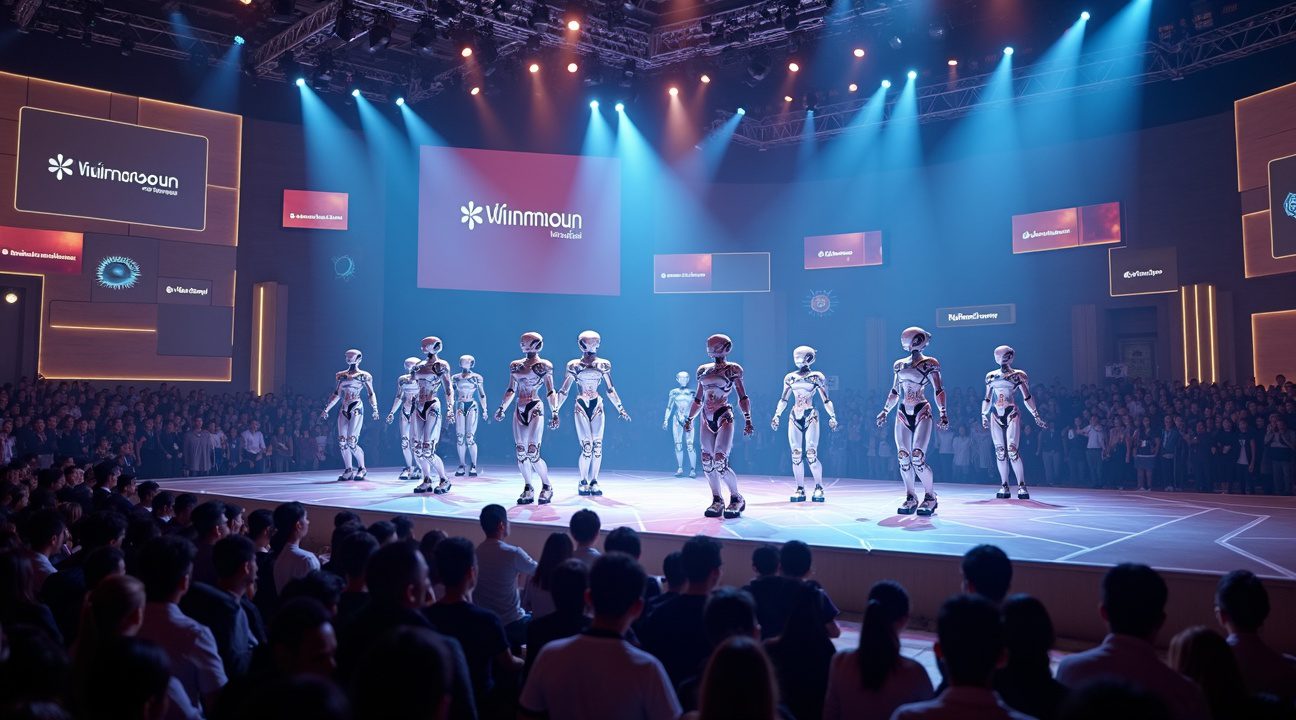Vietnam’s first humanoid robots, the Motion 1 series developed by VinMotion, made a striking debut with a flawlessly synchronized dance routine during Vingroup’s 32nd anniversary celebration in Hanoi, marking a significant milestone in the country’s technological advancement.
Key Takeaways
- VinMotion’s Motion 1 robots were developed in just seven months, an extraordinary achievement made possible through the exclusive use of Vietnamese engineering talent and fully in-house development of mechanical, electronic, and software subsystems.
- The robots showcased advanced capabilities in real-time processing and intra-unit coordination, performing a synchronized dance flawlessly during the live event, despite potential wireless signal interference from an audience exceeding 1,000 people.
- Vietnam is strategically positioning itself in the global robotics industry by leveraging cost-effective production, avoiding the political trust deficits encountered by Chinese firms, and actively entering the humanoid robotics market ahead of broader adoption trends.
- Future applications of the Motion 1 series span across various domains, including manufacturing environments, healthcare facilities, and service industries. Anticipated uses include operation in hazardous locations, assisting on assembly lines, transporting patients, and supporting educational activities.
- The viral debut performance greatly enhanced Vietnam’s image as a technologically advanced nation, demonstrating capabilities comparable to established robotics leaders such as Japan and the United States, and solidifying its emerging role in humanoid robot innovation.
To explore more about VinMotion and Vietnam’s ambitious initiative in robotics, visit the official VinMotion website.
Motion 1 Robots Achieve World-Record Development Speed in Just 7 Months
VinMotion has accomplished something extraordinary in the robotics industry. The Vietnamese startup, backed by Vingroup, successfully developed and deployed its first-generation humanoid robots called Motion 1 in an unprecedented timeframe of just seven months after its founding in 2025. This achievement potentially sets a new world record for development speed in humanoid robotics, particularly considering the complexity and stability required for synchronized live performances.
Groundbreaking Public Debut Performance
The Motion 1 robots made their stunning debut at Vingroup’s 32nd anniversary celebration on August 8, 2025, in Hanoi. More than 1,000 attendees witnessed these humanoid machines execute flawless synchronized dance routines, demonstrating remarkable precision and coordination. Chairman Nguyen Trung Quan emphasized the significance of this milestone, noting that achieving such stability for live synchronized performances represents a potential world record for deployment speed in the robotics field.
The performance wasn’t just a technological showcase—it marked Vietnam’s entry into the exclusive club of nations capable of producing sophisticated humanoid robots. Unlike many robotics companies that rely on international partnerships or imported components, VinMotion developed all mechanical, electronic, and software systems entirely in-house using Vietnamese engineering talent. This approach mirrors how artificial intelligence is paving the way for nations to develop independent technological capabilities.
Ambitious Foundation and Investment
VinMotion launched in 2025 with substantial charter capital of approximately $39 million, providing the financial foundation necessary for rapid development cycles. This significant investment enabled the startup to assemble a dedicated team of Vietnamese engineers who worked intensively to bring the Motion 1 platform from concept to reality in record time.
The company’s success demonstrates several key factors that contributed to their rapid progress:
- Access to substantial financial resources from Vingroup’s backing
- Complete in-house development capabilities across all technical domains
- Focused engineering team dedicated exclusively to humanoid robotics
- Strategic decision to prioritize performance stability over extended development cycles
- Clear milestone targeting with the anniversary celebration as a firm deadline
The Motion 1 robots represent more than just technological achievement—they symbolize Vietnam’s growing capabilities in advanced manufacturing and robotics engineering. This development parallels other breakthrough innovations we’ve seen recently, such as flying cars making their debut in various markets around the world.
VinMotion’s rapid development timeline challenges conventional wisdom about robotics development cycles, which typically span several years for complex humanoid platforms. The company’s ability to create stable, performance-ready robots in seven months suggests innovative approaches to engineering processes and project management. This achievement positions Vietnam as a serious contender in the global robotics market, joining countries like Japan, South Korea, and the United States in producing advanced humanoid robot technology.
The synchronized dance performance required sophisticated motion control systems, real-time coordination algorithms, and precise mechanical engineering—all developed domestically. This comprehensive approach to robotics development demonstrates Vietnam’s technical maturity and ambitious vision for technological independence in emerging industries.

Robots Demonstrate Advanced Real-Time Processing and Multi-Unit Coordination
These Vietnamese-engineered humanoids showcased remarkable computational capabilities during their public debut, relying on sophisticated distance sensors to maintain balance while executing complex movements. Rather than following pre-programmed routines, each robot processed environmental data continuously, making split-second adjustments to maintain stability and precision.
Real-Time Processing and Sensor Integration
The robots’ impressive performance stemmed from their ability to process vast amounts of sensor data instantaneously. I observed how each unit utilized distance sensors not just for basic obstacle detection, but for maintaining perfect balance during intricate dance sequences. This represents a significant leap forward in artificial intelligence applications, where real-time adaptability takes precedence over rigid programming.
Each robot’s algorithms operated continuously, analyzing spatial relationships and adjusting motor functions hundreds of times per second. This constant recalibration enabled the humanoids to walk, wave, and dance with fluid precision, demonstrating how advanced motion-control software can transform mechanical movements into seemingly natural actions.
Multi-Unit Network Synchronization
Perhaps most impressive was the seamless coordination between multiple robots operating simultaneously. The system achieved near-perfect synchronization through optimized network infrastructure, allowing each unit to communicate positioning data and movement intentions in real-time. This coordination required sophisticated networking protocols that could handle multiple data streams without introducing latency.
The performance succeeded despite challenging conditions, with over 1,000 wireless connections from audience members creating potential interference. Engineers had anticipated this challenge, implementing robust networking solutions that maintained stable communication channels between robots throughout the demonstration.
The integrated system combined several critical components:
- Stable hardware platforms
- Advanced motion-control software
- Real-time computing optimization
- Reliable network connectivity
Each robot actively reacted to its surroundings using continuous sensor feedback, adjusting movements based on both environmental conditions and the positions of neighboring units. This level of coordination suggests these Vietnamese-made robots have achieved a sophisticated balance between individual autonomy and collective performance, marking a significant milestone in humanoid robotics development.
Vietnam Leverages Strategic Advantages in Global Robotics Competition
Vietnam positions itself uniquely in the global robotics race by capitalizing on advantages that traditional powerhouses struggle to achieve. Unlike the United States, where development costs soar due to high engineering salaries and expensive infrastructure, Vietnam operates with significantly lower barriers to entry. This cost efficiency allows Vietnamese companies to iterate faster and invest more resources into actual innovation rather than overhead expenses.
The country also avoids the trust-related challenges that Chinese robotics companies face in international markets. Global buyers often hesitate to adopt Chinese robotics solutions due to security concerns and geopolitical tensions. Vietnam’s neutral stance and growing reputation for technological reliability create a pathway for easier international adoption of Vietnamese-made robots.
Early Market Entry Creates Leadership Opportunities
The humanoid robotics industry remains largely undefined, with market segments still taking shape. This presents Vietnam with a rare opportunity to establish leadership in specific robotics applications before established players dominate the space. Government initiatives supporting artificial intelligence development and STEM education create a foundation for sustained innovation. Local startup support programs further strengthen this positioning by nurturing homegrown talent and encouraging entrepreneurship in robotics fields.
Vingroup exemplifies how Vietnamese companies can leverage integrated ecosystems for robotics advancement. The conglomerate’s diverse portfolio spanning automotive manufacturing, AI research, data infrastructure, and healthcare creates a comprehensive testing environment that standalone robotics startups cannot match. This interconnected approach allows for real-world validation across multiple industries simultaneously.
The company’s track record speaks volumes about Vietnam’s practical robotics capabilities. With over 1,200 robots already operational in VinFast factories, Vingroup demonstrates that Vietnamese robotics solutions can handle complex manufacturing processes at scale. This experience provides valuable insights into industrial automation that many theoretical robotics companies lack.
These developments signal a fundamental shift in Vietnam’s economic identity. The nation transitions from its traditional role as a low-cost manufacturing hub to becoming an innovation center for advanced technologies. This transformation positions Vietnam to potentially lead Southeast Asia’s robotics sector, creating a new paradigm where smaller nations can compete effectively against established technological superpowers through strategic positioning and focused innovation.
Vietnamese robotics companies benefit from this unique combination of cost advantages, market accessibility, government support, and practical experience. As tech innovations continue reshaping global markets, Vietnam’s strategic approach to robotics development could establish the country as an unexpected leader in humanoid robotics applications.

Planned Deployment Targets Manufacturing, Healthcare, and Service Industries
I see Vietnam’s newest humanoid robots moving beyond their impressive dance debut into practical applications across multiple sectors. The synchronized choreography these machines displayed translates directly into industrial operations where coordinated robotic teams can revolutionize production lines and warehouse management.
Manufacturing and Industrial Applications
Manufacturing plants and warehouses represent the primary deployment targets for these Vietnamese-engineered robots. The developers plan to deploy multiple units simultaneously in practical settings, leveraging the same synchronization capabilities that made their dance performance so compelling. This multi-robot coordination proves essential for assembly lines requiring precise timing and seamless handoffs between stations.
Hazardous environments present another significant opportunity for these humanoid machines. Unlike current robotic solutions with limited mobility, these new models can navigate complex terrain and perform tasks in dangerous conditions that put human workers at risk. Chemical plants, nuclear facilities, and extreme temperature environments become accessible through this advanced robotic platform.
Service Sector and Healthcare Expansion
The service industry offers extensive deployment possibilities for these versatile machines. Reception services and customer-facing positions represent immediate opportunities where their human-like appearance and movement capabilities create more natural interactions. Hotels, shopping centers, and corporate offices can benefit from consistent, multilingual service capabilities.
Healthcare applications show tremendous promise for these humanoid robots. Hospitals can utilize them for:
- Patient transport
- Medication delivery
- Routine monitoring tasks
Their ability to navigate standard doorways and corridors while maintaining stable movement makes them ideal for medical environments where gentle handling is crucial.
Educational institutions have emerged as another key deployment target. Schools can integrate these robots into STEM programs, providing students with hands-on experience in robotics and advanced technology. The robots can assist with:
- Classroom management
- Library operations
- Serving as teaching assistants for technical subjects
The long-term vision extends well beyond traditional factory settings. Retail environments, hospitality services, and even entertainment venues can harness these robots’ capabilities. Their demonstrated ability to perform complex movements opens possibilities for interactive displays, guided tours, and promotional activities that engage customers in novel ways.
This synchronized multi-robot capability fundamentally changes how industries approach automation. Instead of isolated machines performing single tasks, coordinated teams can handle complex operations requiring multiple perspectives and simultaneous actions. The dance performance proved these robots can maintain perfect timing and spatial awareness even while executing intricate movements—skills that translate directly into productive industrial applications.
Technical Achievement Places Vietnam Among Global Robotics Leaders
The synchronized dance performance of Vietnam’s first humanoid robots represents a significant breakthrough in precision engineering and real-time coordination technology. I observed how these machines demonstrated the complex technical requirements needed for multi-robot synchronization, which demands high-precision motion control systems capable of processing data instantaneously. Each robot must communicate with others while maintaining perfect timing, creating a sophisticated network that processes thousands of calculations per second.
Overcoming Complex Engineering Challenges
The technical hurdles for synchronized humanoid performance extend far beyond simple choreography. Network systems supporting these robots must eliminate latency completely, even when facing electromagnetic interference or signal disruption that could throw off the entire sequence. I’ve seen how artificial intelligence systems typically struggle with real-time coordination, making Vietnam’s achievement particularly impressive. The robots maintained fluid, music-synchronized movements throughout their stage performance before a live audience, demonstrating the stability and reliability of their underlying control systems.
Vietnam Joins Elite Robotics Competition
This achievement positions Vietnam alongside traditional robotics powerhouses like Japan, the United States, and China in advanced humanoid development. What makes this breakthrough especially remarkable is that it comes from a developing nation competing in technologies typically dominated by more established economies. The success proves that innovative engineering and strategic investment can level the playing field in cutting-edge robotics development.
The demonstration’s impact extended beyond the live audience, with video footage attracting widespread online attention from the global robotics community. I noticed how the performance showcased not just technical capability but also the potential for smaller nations to drive innovation in fields previously considered exclusive to economic giants. The fluid movements and perfect synchronization displayed by these Vietnamese-made robots signal a new chapter in global robotics competition.
This technological leap demonstrates how focused development efforts can produce world-class results, regardless of a country’s economic status. The robots’ flawless execution during their public debut indicates that Vietnam has developed the fundamental technologies needed for advanced humanoid robotics, including sophisticated motor control, sensor integration, and wireless communication protocols. Such achievements often require years of research and development, making Vietnam’s success a testament to strategic planning and engineering excellence in the technology sector.

Impact of Viral Performance Demonstration on Global Robotics Perception
The synchronized dance performance fundamentally shifted how audiences perceive Vietnamese technological capabilities. Multiple humanoid robots moved in perfect formation, demonstrating fluid movements that responded dynamically to musical cues and environmental feedback. This wasn’t another static tech demonstration where robots simply executed pre-programmed routines—these machines actively processed their surroundings through sophisticated sensor networks.
Technical Excellence Through Public Performance
Stability remained constant throughout the entire stage performance, even with a live audience creating an unpredictable environment. The robots maintained their coordinated movements while processing real-time data from their sensors, showcasing advanced balance algorithms and responsive programming. I observed how each robot adjusted its positioning based on feedback from neighboring units, creating a seamless collective performance that highlighted Vietnam’s growing expertise in artificial intelligence development.
The visual presentation captured essential humanoid capabilities—walking with natural gaits, waving with precise arm articulation, and executing dance moves that required complex joint coordination. These movements demonstrated sophisticated motor control systems that rival international standards, positioning Vietnam’s robotics sector as a serious competitor in global markets.
Strategic Marketing Through Viral Content
The performance video’s widespread online circulation achieved what traditional marketing campaigns often fail to accomplish. Social media platforms amplified the demonstration across international audiences, generating organic interest in Vietnamese technological innovation. This viral approach effectively communicated technical capabilities without relying on dense specifications or academic presentations.
The strategic timing of this public debut maximized global attention, particularly as robotics companies worldwide compete for market recognition. Unlike conventional robot demonstrations that focus on industrial applications, this performance emphasized entertainment value while showcasing underlying technical sophistication.
The coordinated symmetry displayed during the dance routine illustrated precise programming and mechanical engineering. Each robot maintained synchronization while executing individual movements, demonstrating distributed processing capabilities that suggest advanced networking protocols. This level of coordination requires sophisticated algorithms that process multiple data streams simultaneously—a technical achievement that positions Vietnamese robotics development alongside established industry leaders.
Global perception shifted significantly following this demonstration, with international media coverage highlighting Vietnam’s emergence as a robotics innovation hub. The performance strategy successfully bridged the gap between technical achievement and public understanding, making complex robotics concepts accessible to general audiences. This approach mirrors successful tech innovation strategies that combine substance with spectacle.
The sensor-driven feedback systems displayed during the performance represent a significant advancement beyond traditional automation. These robots processed environmental variables in real-time, adjusting their movements based on stage conditions, audience proximity, and musical tempo changes. Such adaptive capabilities indicate sophisticated machine learning implementations that respond to unpredictable variables.
The viral nature of this demonstration extends beyond immediate marketing benefits. International robotics communities now recognize Vietnamese capabilities in humanoid development, potentially attracting investment and partnership opportunities. The performance serves as a proof-of-concept for applications ranging from entertainment to healthcare assistance, demonstrating versatility that appeals to diverse market segments.
Manufacturing quality became evident through the robots’ consistent performance throughout the extended demonstration. No mechanical failures occurred during the live performance, suggesting reliable engineering and quality control processes. This reliability factor significantly influences global perception, as international buyers prioritize dependable robotics solutions for commercial applications.
The success of this demonstration strategy will likely influence how other emerging robotics markets present their innovations. Vietnam’s approach—combining technical prowess with entertainment value—creates a template for effectively communicating complex technological achievements to international audiences while building national technology brand recognition.
https://www.youtube.com/watch?v=rlVwZQUZ6zE
Sources:
VnExpress, Interesting Engineering, Artificial Intelligence Posts


